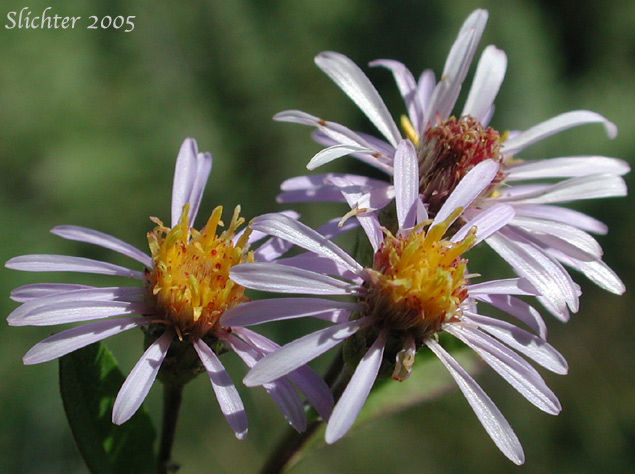The photo above shows part of the inflorescence
of rough-leaved aster as seen along the Island Springs Trail #66 at the location
denoted below..........August 25, 2005. Note the narrow disk and lavender,
propellor-shaped ray flowers.
1. Along Island Springs Trail #66 from about 30 meters west
of N 46¾ 10.021' W 121¾ 23.656' Elevation 5122' +/- 31' to near the top of the
ridge.
2. Along the Hell Roaring Creek Trail #10 on slopes to the north
of Hell Roaring Creek and also along this trail between Bench Lake and a large
rocky slope.
3. Rd K6000 in open woods at about 2800' on the southeastern
flanks of the mountain.
4. On open slopes around the DNR Rock Quarry at the end of road
K6900 on the southeast side of the mountain.
5. Willard Springs Trail in Conboy Lake NWR.
The photo at left shows the upper stem of rough-leaved
aster as seen along the Island Springs Trail #66 on the eastern slopes of Mt.
Adams. Note the alternating leaves and the slightly zigzag appearance of the
stem. The photo at center shows the involucral bracts
of rough-leaved aster as seen along the Island Springs Trail #66...........August
25, 2005. Note the shingled appearance of the purple-tipped involucral bracts.
The
fleabanes (genus
Erigeron) and asters
are often both similar in appearance and can be distinguished partly by bloom
period (the fleabanes tend to bloom earlier and the asters later) and by the
arrangement of the involucral bracts. The bracts of the asters, as seen here,
tend to overlap like shingles, with the outermost the shortest and the innermost
the longest. All the bracts of the fleabanes tend to be roughly the same length. The photo at right shows the lower leaf surface
of rough-leaved aster. The blades tend to be slightly wider toward the tips
and narrow gradually to the base. All images from the Island Springs Trail #66, Bird Creek Meadows....August 25, 2005.
Early spring leaves
of rough-leaved aster as seen from forest along a vernally moist drainage running west off of Dead Canyon about two miles or so west of the Klickitat River.....May 9, 2025.
